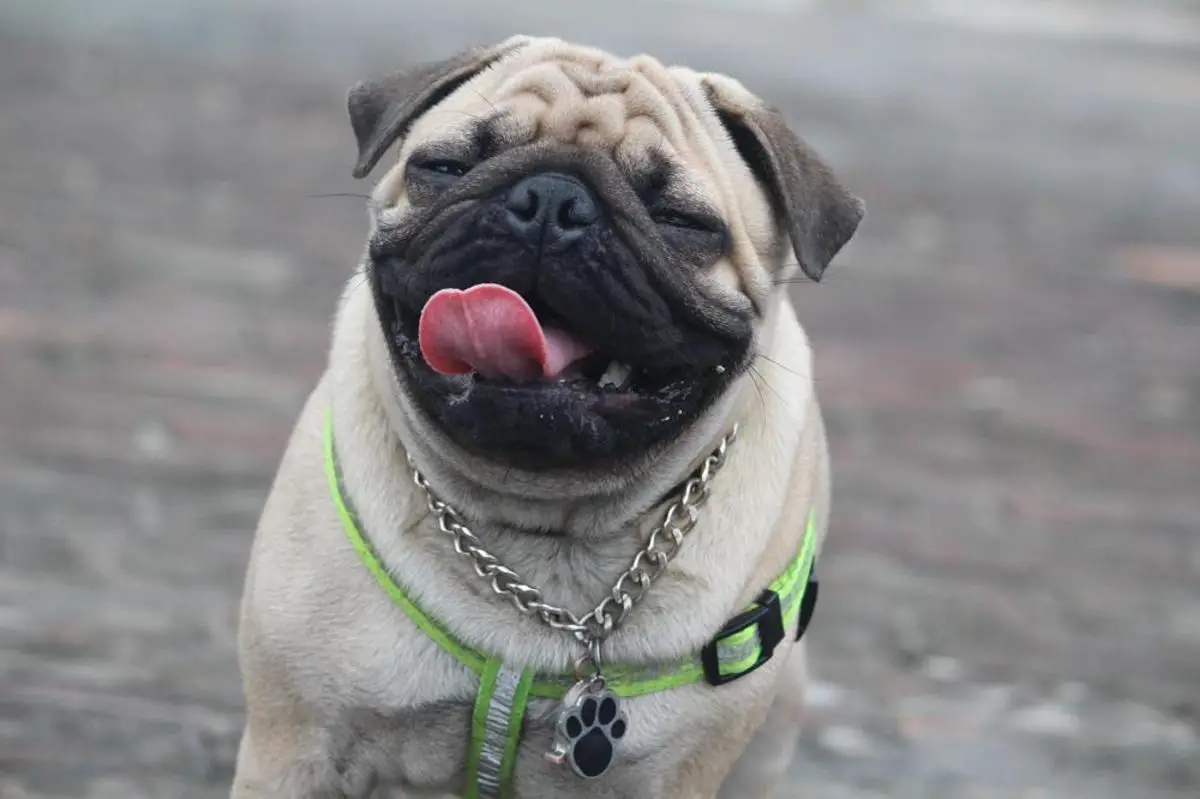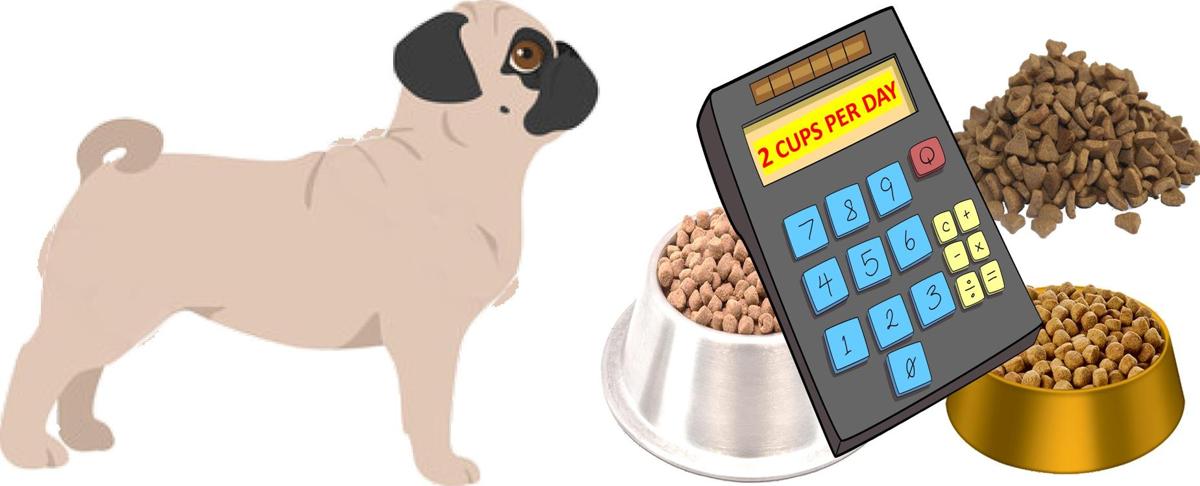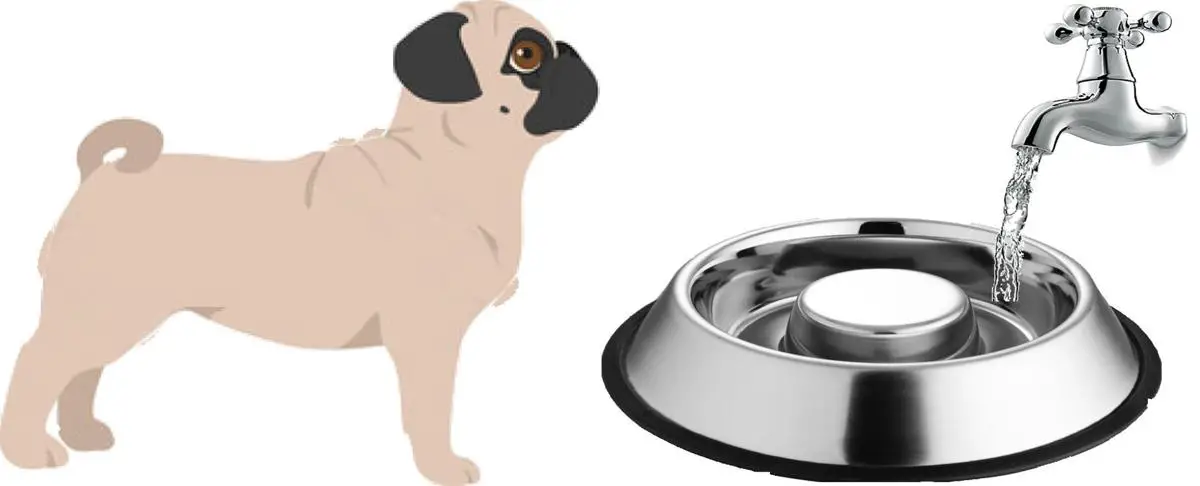Quick Links: Table of Contents
- Pug Breed Overview
- History of the Pug Breed. Where Pugs came from
- What the Pug Looks Like
- How Much is the Pug Puppy?
- Best Pug Breeders
- Adopting or Rescuing the Pug
- Pug Growth
- The Temperament of the Pug
- How Long Pugs Live
- Pug Litter Size
- How Fast Pugs Can Run
- Good Names for Pugs
- How Intelligent are Pugs?
- How Popular are Pugs with New Dog Owners?
- Health Problems in Pugs and How to Prevent Them
- How to Take Care of Pug
- Dog Breeds That Are Similar to Pugs
- Other Things to Know About Pugs
Pug Breed Overview
The Pug is a small-sized dog.
The adult Pug stands 10 to 14 inches tall at the shoulder.
The Pug belongs to the Companion Dogs group.
Dogs in the Companion Dogs group, like the Pug, were bred to be companions for humans. Their main goal in life is to be with people, and they will be very sad if left to themselves for long hours day after day.
The fact that the Pug belongs to the Companion Dogs group is one of the reasons why Pugs have the personality and temperament that they have.
The temperament of the Pug is generally described as:
- Affectionate
- Attentive
- Calm
- Charming
- Clever
- Docile
- Loving
- Mischievous
- Playful
- Quiet
- Sociable
- Stubborn
History of the Pug Breed. Where Pugs came from
Pugs are one of the most popular dog breeds in the world, and it’s not hard to see why.
These small, affectionate dogs have been bred for centuries to be companions, and their gentle dispositions make them ideal pets.
Pugs have a long and fascinating history that dates back to ancient China.
The Pug is believed to be the outcome of a cross between themastiff and the Pug, two ancient breeds of dogs.
Pugs were first mentioned in Chinese documents as early as the 12th century, and they were soon prized as companion animals by Buddhist monks.
From China, the Pug spread to other parts of Asia, and eventually made its way to Europe.
Initially, Pugs were only owned by royalty and the upper class, but over time they became more popular with the general public.
Today, Pugs are enjoyed by people all over the world, and their friendly dispositions continue to make them one of the most beloved dog breeds around.
.
What the Pug Looks Like
Pugs are a small breed of dog with a distinct appearance.
They have large, round eyes, a short muzzle, and wrinkled skin.
They come in a variety of colors, including fawn, black, and silver.
Pugs are known for being sociable and affectionate dogs.
They are also relatively easy to train.
Pugs are generally healthy dogs, but there are some health problems that are more common in this breed.
These include Pug Dog Encephalitis, a potentially fatal disease that affects the brain, and von Willebrand`s Disease, a bleeding disorder.
Pugs also tend to snore and may have difficulty breathing due to their short noses.
Despite these potential health problems, pugs make great companion animals for people of all ages.
.
How Much is the Pug Puppy?

The average price of a Pug puppy is $1620. The price of a Pug puppy ranges from $1200 to $1875.
A lot of factors determine the price of the Pug. These factors include what health records the Pug puppy has, the lineage of the Pug puppy, the US state the breeder is located in, etc.
To estimate how much you can expect to pay for a puppy Pug based on the many factors that determine the price of the Pug puppy, check out our calculator that lets you estimate how much you should expect to pay for the Pug puppy based on what you want in the puppy.
When looking to buy a puppy, look at buying a puppy only from well-established breeders that breed puppies primarily for the love of the Pug breed, and secondarily for profit. Do not buy a puppy from a puppy mill. Puppy mills mass-produce puppies in bad living conditions for maximum profit.
You may also consider adopting instead of buying a puppy. Adoption costs are very low compared to the price of a puppy.
Best Pug Breeders
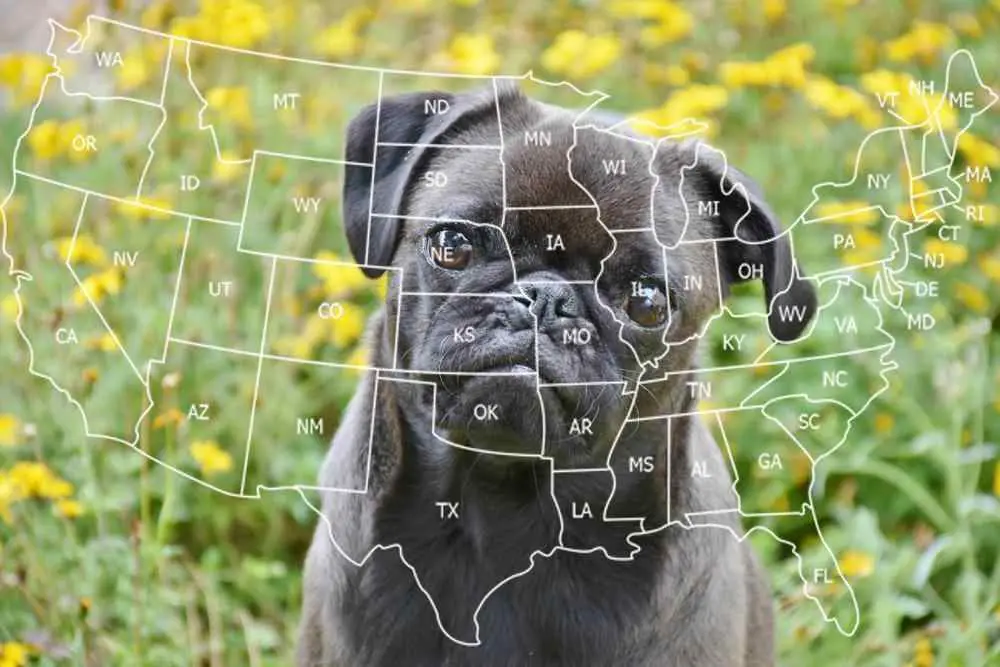
We have researched reputable Pug breeders that you can buy a puppy.
Go to this page for our complete list of reputable Pug breeders in various states in the United States.
On this page, you will see how much these breeders sell their puppies for, and how many puppies they have available.
A few of these breeders are listed below.
FAIRYTALE FRENCHIES
Puppy Price: $2000
Argentine Pugs
Puppy Price: Check with breeder
Sir Henry Humpsalot/STUD SERVICE
Puppy Price: $2000 +
Call 610-593-6037 for play date today u2764ufe0f
Puppy Price: $2000
Pam`s Pugs
Puppy Price: Check with breeder
Adopting or Rescuing the Pug
You may consider adopting a dog instead of buying a puppy. Many dogs, Pugs included, are currently available for adoption in your local dog shelters.
These helpless but adorable dogs are waiting in dog shelters hoping that someday someone will rescue them. Dog adoption costs are lesser than the cost of a new puppy. Dog adoption costs are usually around $300 or even less.
In addition to your local dog shelter, another good place to find dogs that are available for adoption is petfinder.com.
Below is an adorable Male Pug named Simba that is currently available for adoption on Petfinder.com. You can find other lovely Pugs like Simba on pefinder.com.

Piggy is the name of another Pug (Male) on petfinder.com that is looking for a new forever home.

You can find more Pugs that are available for adoption on petfinder.
Pug Growth

New Pug owners need to know about the growth of their Pugs. This will help them plan their living spaces accordingly.
Also, knowing the typical growth pattern of the Pug will help new owners catch the abnormal growth of their Pug early.
See our calculator for predicting how big your Pug puppy will get. You will also learn about the typical weight of the Pug at different ages and how to catch abnormal growth in your Pug

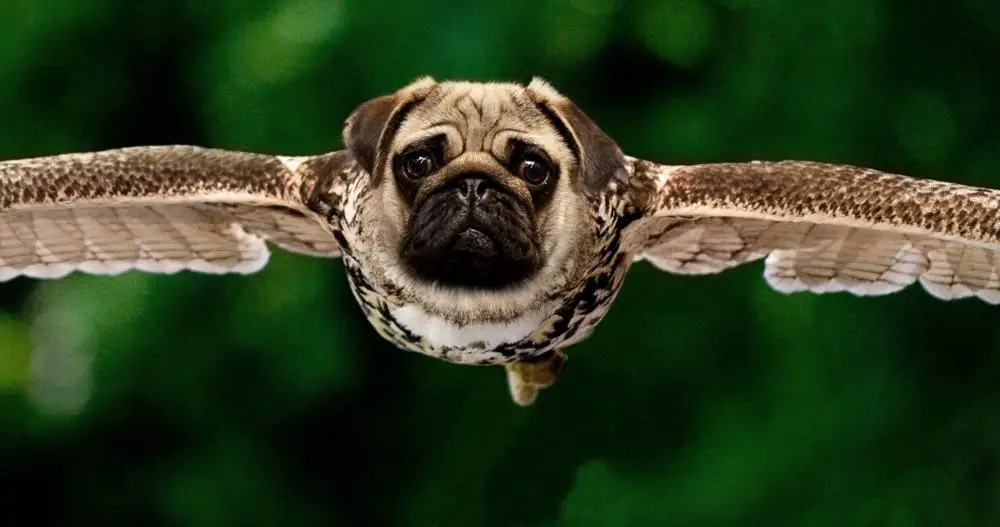
The Temperament of the Pug
The temperament of the Pug based can be summarized as in the table below.
The table shows the scores of the Pug for 13 important dog behavioral factors.
We obtained these scores by analyzing raw data from the C-BARQ dog personality survey tool. The higher the score of a dog for a factor, the worse the temperament of the dog regarding that factor.
The C-BARQ tool was developed by researchers from the University of Pennsylvania, and it is a scientific tool that is used worldwide for reliably measuring the temperament of dog breeds.
See our complete analysis of the temperament of the Pug here.
| Factor | Score |
|---|---|
| Attachment Attention Seeking | 70.5 percent |
| Excitability | 55.2 percent |
| Stubbornness | 54.1 percent |
| Touch Sensitivity | 48.7 percent |
| Separation Related Behavior | 47.8 percent |
| Energy Level | 46.5 percent |
| Dog Directed Fear | 38.7 percent |
| Nonsocial Fear | 24.1 percent |
| Stranger Directed Aggression | 23.7 percent |
| Dog Directed Aggression | 21.4 percent |
| Stranger Directed Fear | 21.2 percent |
| Dog Rivalry | 19.2 percent |
| Owner Directed Aggression | 15.4 percent |
| Prey Drive | 0.0 percent |
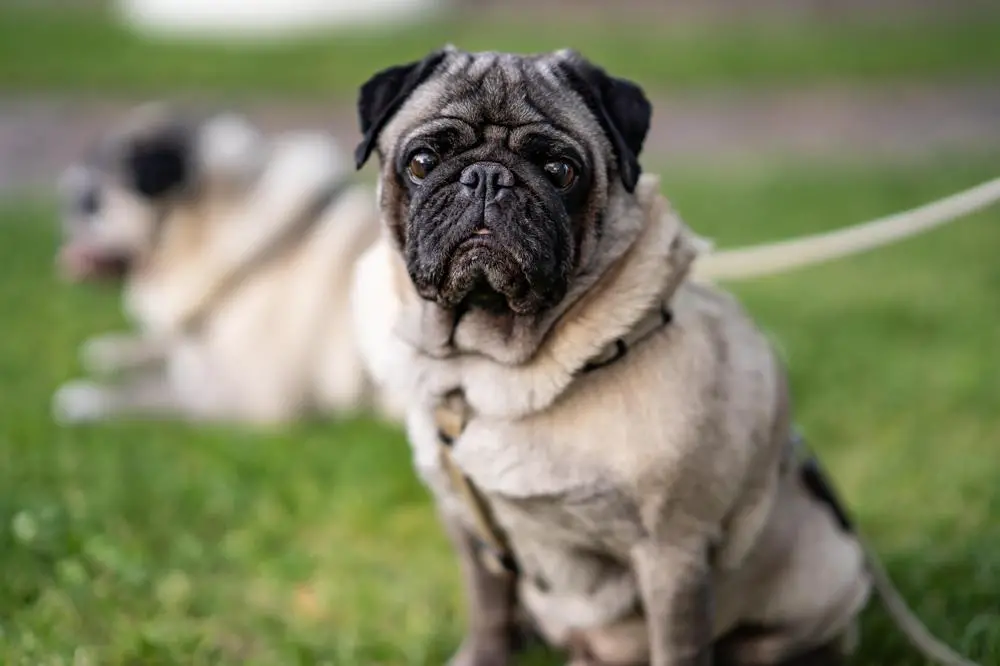
How Long Pugs Live
The lifespan of the Pug is typically from 12 to 15 years.
Moreover, a few years back, veterinarian researchers performed a scientific study to determine the lifespan of the Pug. In this study, the scientists collected data on how long 163 pet Pugs lived.
From the study, it was found that Pugs have an average lifespan of 11 years. Furthermore, the study found that it is not uncommon for Pugs to live as long as 17 years.
Note that you need to put in some effort if you want your Pug to live long.
Pugs live long if they eat well, drink well, exercise well, and visit the veterinarian regularly.
There are also dog supplements that you can give your Pug to improve your Pug`s quality of their life.
Click here to learn more about how to make your Pug live long.

Pug Litter Size
Researchers from the Norwegian School of Veterinary Science did a study where they counted the numbers of puppies in 120 different Pug birth litters.
From this study, the researchers found that the average number of puppies that Pugs can have is 4 puppies. Also, the Pug can have as few as 1 puppies per litter and as many as 8 puppies per litter.
The number of puppies that the Pug will have depends on factors such as the age of the Pug, the method of pregnancy, etc.
Click here to see our calculator for predicting how many puppies your Pug will have and how the litter size of the Pug compares to the litter size of other dog breeds.
How Fast Pugs Can Run

How fast a dog breed can run is a good measure of how athletic the dog breed is.
The American Kennel Club (AKC) regularly conducts dog running competitions. The AKC records the running speed of competing dogs in these competitions. These competitions are open to all dog breeds.
Based on our analysis of the speeds of 26 different Pugs, the average speed of the Pug is 15.7 mph (25.2 kmph).
The fastest speed on AKC record that the Pug ran in a race is 21.68 mph (34.9 kmph) and the minimum speed on record in a race for a Pug is 4.35 mph (7.0 kmph).
Click here to see how the speed of the Pug compares to the speed of other dogs and other mammals such as cats, horses, humans, etc.
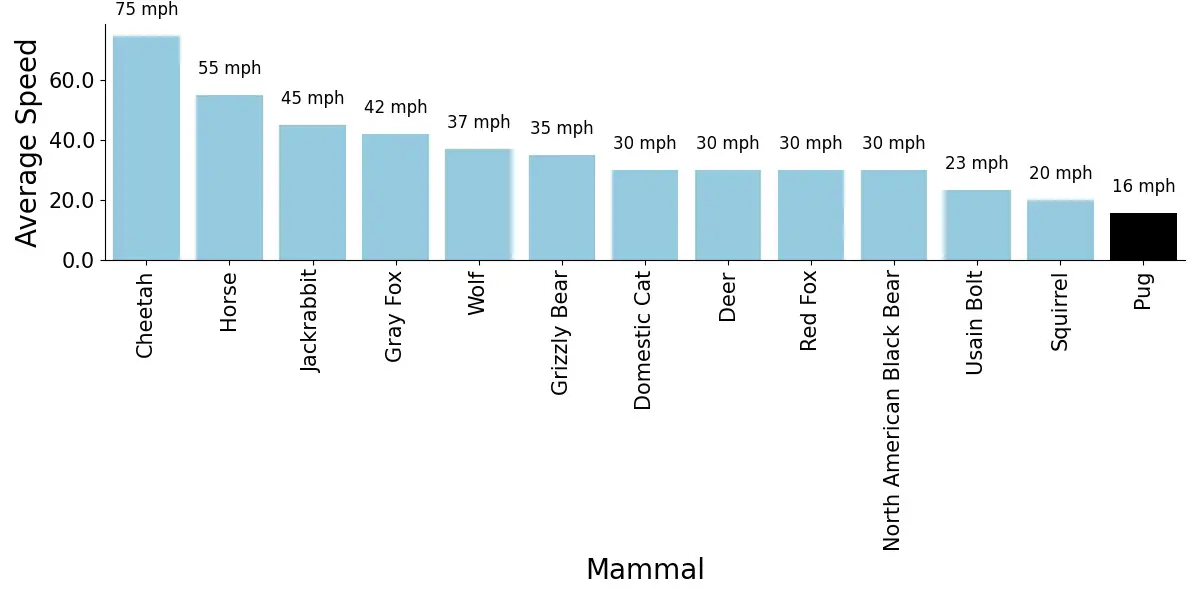
Good Names for Pugs
Here are some really good names that are typical for the Pug ranked by popularity:
- Frank
- Pugsley
- Percy
- Bruno
- Rocky
- Dog
- Oliver
- Bashful
- Doug
- Barney

How Intelligent are Pugs?
| Pug | |
|---|---|
| Intelligence Rank | 57 out of 130 dog breeds |
| Trainability | Tend To Learn New Commands After 40 To 80 Repetitions! |
According to Prof. Stanley Coren, a Canadian psychology professor/dog trainer, the total intelligence that a dog demonstrates is the addition of three types of intelligence. These intelligence types are:
- Instinctive Intelligence: This is the natural intelligence that comes from instinct. For example, dog breeds that have been historically bred to be guard dogs will have a high `guarding` intelligence compared to dogs that were not bred for guarding.
- Adaptive Intelligence (learning and problem-solving ability): This indicates what a dog can learn to do for himself or herself. Adaptive intelligence is specific to each dog, and not breed specific. You can improve your dog`s adaptive intelligence by investing time to train your dog.
- Working/Obedience Intelligence: This type of intelligence is breed-specific. Certain dog breeds tend to have higher working/obedience intelligence than some other breeds. This intelligence is the closest to what we might call school-learning ability and it is based upon what the dog can learn to do when instructed by humans. This type of intelligence can be measured for each dog breed and compared to that of other dog breeds.
Professor Stanley Coren measured and ranked the working intelligence of about 130 different dog breeds.
Prof. Coren found that the Pug has an obedience intelligence rank of 57 out of 130 dog breeds. Thus, Prof. Coren put Pugs in the `Fair Working/Obedience Intelligence Dogs` category.
This means that Pugs tend to learn new commands after 40 to 80 repetitions!.
However, we should mention that a dog should not be judged based on its intelligence alone. There are other important factors you need to consider when deciding on which dog breed to get. These other factors include sociability, adorability, and compatibility of the dog breed with your lifestyle.
See the intelligence ranking of some other dog breeds below:
| Breed | Intelligence Rank |
|---|---|
| Golden Retriever | 4 |
| Rottweiler | 9 |
| Miniature Schnauzer | 12 |
| English Springer Spaniel | 13 |
| Collie | 16 |
| Irish Water Spaniel | 24 |
| Samoyed | 33 |
| Affenpinscher | 37 |
| Dalmatian | 39 |
| Finnish Spitz | 43 |
| American Foxhound | 46 |
| Dachshund | 49 |
| Pug | 57 |
| Maltese | 59 |
| Bullmastiff | 69 |
| Beagle | 72 |
| Pekingese | 73 |
| Chow Chow | 76 |
| Basenji | 78 |
| Afghan Hound | 79 |
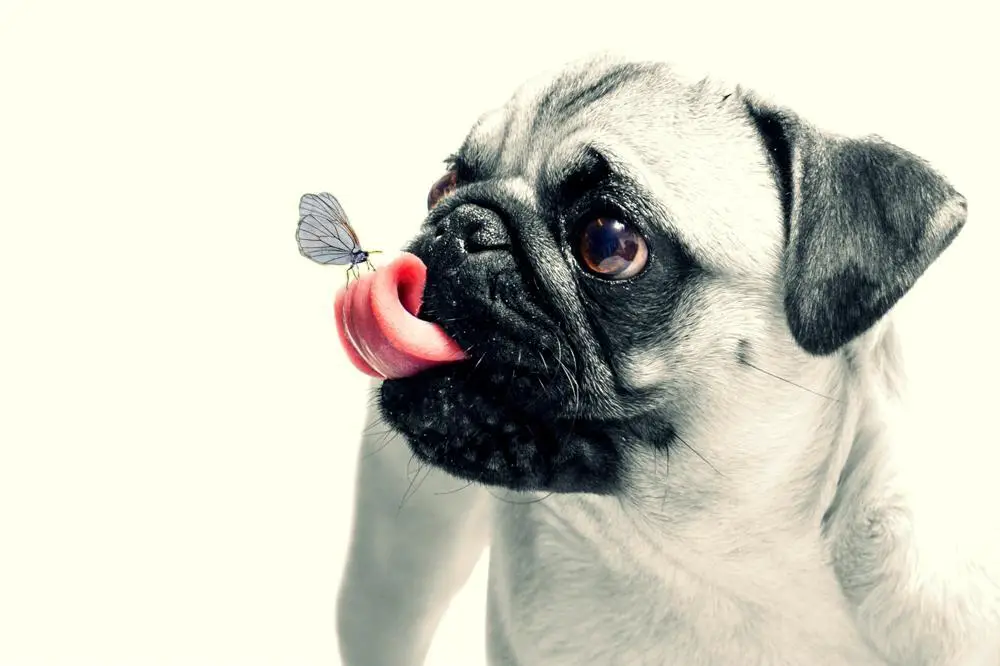
How Popular are Pugs with New Dog Owners?
Every year, the American Kennel Club (AKC) publishes information on how popular a dog breed is in that particular year. The AKC gets the popularity information of a breed from how many dogs of that breed the owners register with the AKC every year. The AKC collects this data for about 200 dog breeds.
The graph below shows the popularity trend of the Pug.
The popularity of the Pug averaged over the years is Number 31 out of about 200 dog breeds.
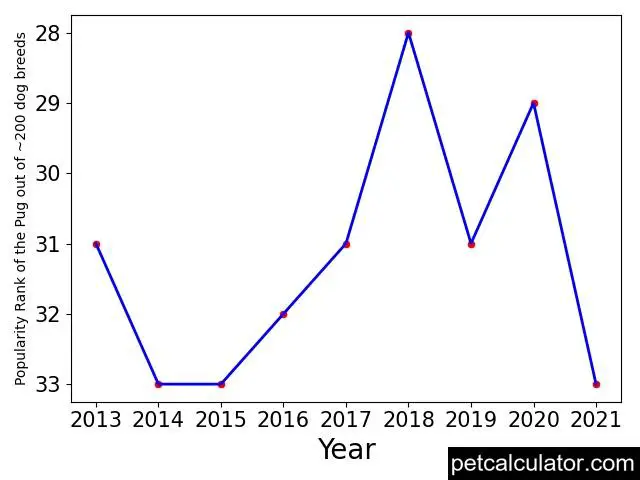
Do not get a dog breed just because it is a popular dog breed. And do not reject a dog breed just because it is an unpopular breed.

Health Problems in Pugs and How to Prevent Them
Every dog breed has its own set of health problems that it tends to develop. There is nothing like a perfect dog breed.
The Pug is prone to certain genetic health conditions. The Orthopedic Foundation for Animals (OFA) is an organization that keeps track of genetic health problems in dog breeds.
From the extensive records that the OFA keeps, the OFA knows what health problems each dog breed is naturally prone to develop.
Hence, the OFA recommends which health screening breeders should perform on a dog breed to make sure that the breeders won`t breed `defective` dog parents that can pass down defective genes to their puppy offspring.
If you want a Pug puppy that will grow up to be healthy, make sure that your Pug breeder screens your puppy or your puppy`s parents for the health problems that the OFA recommends for your puppy`s breed. This will increase the chances that your puppy is free from genetic defects.
The following are the health tests that Orthopedic Foundation for Animals (OFA) recommends that breeders should screen Pugs for:
- Elbow Dysplasia
- Eye Examination- Pug Dog Club of America recommends ANNUAL screening.
- Hip Dysplasia
- Patellar Luxation
- Pug Dog Encephalitis
- Pyruvate Kinase Deficiency (PKD)
- Serum Bile Acid Test
You can find out more about OFA`s recommended tests for Pugs here.

How to Take Care of Pug
To take good care of your Pug, you need to make sure that you groom your Pug regularly.
Secondly, you need to find a veterinarian in your area that will routinely check the health status of your Pug regularly, and give you appropriate recommendations on your Pug`s preventative care.
Thirdly, you need to commit some time to exercise your Pug daily. Regular exercise helps improve the health and quality of life of your Pug.
Also, you need to feed your Pug high-quality dog food, and the food should be of the right amount to prevent your Pug from getting overweight or underweight.
See our recommendations on what to feed the Pug and how much food to feed the Pug at different life stages.
Finally, you need to make sure that your Pug has access to clean water all the time. See our recommendations on how much water your Pug needs to drink at different ages.
Dog Breeds That Are Similar to Pugs
If you have not made up your mind on which dog breed to get, you may also want to consider some other dogs similar to the Pug.
We crunched the numbers and found that the following dog breeds that have similar behavior and temperament as the Pug:
- Boxer (74 percent match with Pug). Learn more about the Boxer here.
- Beaglier (72 percent match with Pug). Learn more about the Beaglier here.
- English Toy Spaniel (73 percent match with Pug). Learn more about the English Toy Spaniel here.
- French Bulldog (83 percent match with Pug). Learn more about the French Bulldog here.

Other Things to Know About Pugs
Here are some of the very important characteristics of the Pug that you need to know about the Pug breed:
